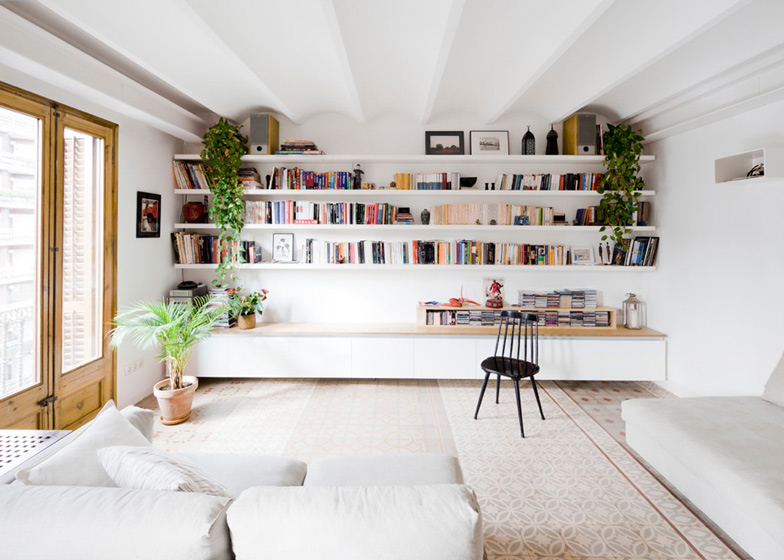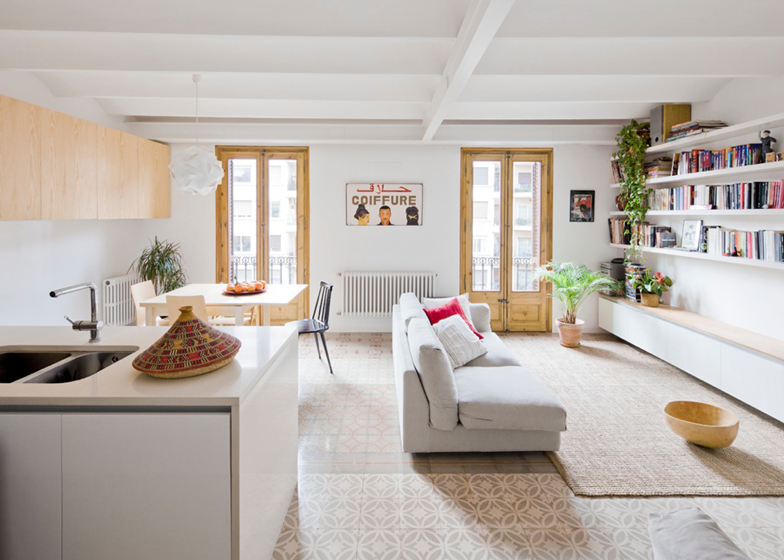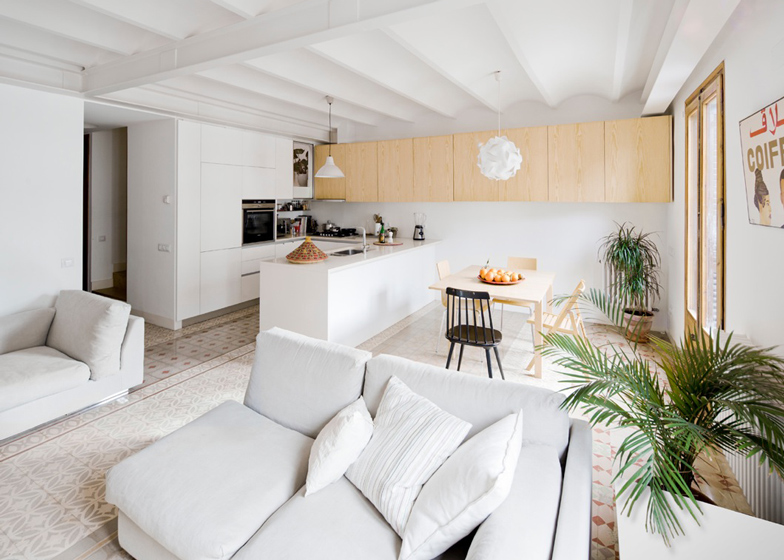Decorative tiles salvaged from different apartments are rearranged in stripes across the floor of this Barcelona residence by Spanish studio Bach Arquitectes (+ slideshow).
Architects Anna and Eugeni Bach were asked to renovate a pair of existing apartments on the upper two floors of a housing block in Barcelona's Eixample district to create a two-storey home for a young family, which is named Urgell Apartment.
While the upper flat had been built in the 1960s, the one below it was considerably older and still contained some of the original encaustic floor tiles, which were made by pouring differently pigmented ceramics into a mould divided by walls before pressing the tiles to create a pattern that goes right through.
"In Barcelona it is quite typical to find these kind of tiles in old flats from the end of the nineteenth century and beginning of the twentieth," Eugeni Bach told Dezeen. "The problem was that there were not enough tiles for the whole flat because in some rooms they had been replaced for newer ones."
Luckily, the architects managed to find more of the tiles when another flat in the block was being refurbished. "We asked them what they were doing with the old tiles and they wanted to get rid of them, so we took them to our site," said Bach.
With seven different kinds of tiles, the architects created a variety of stripes across the entire lower floor, including a large living and dining room, a children's bedroom and a small bathroom.
A new pine staircase ascends to a master bedroom, bathroom and study on the level above.
This staircase is contained with a boxy structure that encompasses kitchen units and storage closets on the lower level, as well as laundry facilities and a desk on the upper floor.
"The second most important material in the flat is the pine wood for the cupboards, the stairs and the flooring on the upper level," added Bach.
Two voids are punched through the stairwell to improve views between floors. The first is a window that looks through to the kitchen, while the second provides a view onto the stairs from the study.
A decked terrace runs along the side of the upper floor and features a folding metal staircase that leads up to a larger terrace on the top of the roof.
It's become quite fashionable to retain or reuse this type of traditional floor tile in Barcelona - see our slideshow of similar projects here.
Here's some extra information from Bach Arquitectes:
Apartment Refurbishment in Urgell, Barcelona
The top two floors of a block in Barcelona's Eixample should be reformed into a single apartment that could take advantage of the existing terraces.
The lower floor consisted of an apartment of about 65 m2, heading the street and getting some light to the kitchen and bathroom via an inner patio. The upper apartment, of about 40 m2, had been built later, probably during the 60s. It consisted of a simple volume built on the terrace, separated from the street and from one of the neighbouring buildings, leaving an L-shaped narrow open space.
The organisation of the apartment orbits around the staircase. This element becomes something more than just a communication device between the two floors by absorbing the kitchen and a storage space on the lower level, and the study and laundry space on the top floor. The staircase is as well the space for visual relationship between the two floors, via an inner window and a big opening on the upper studio which allows to get visual contact from the upper floor until the kitchen downstairs. This easy visual contact helps you understand the flat as a whole, and not just as the superposition of two different floors.
Given the surface of each floor, we understood that we had to organise the lower one as the main floor, which accommodates the entry, living room, dining room, kitchen, a room for children and a bathroom; while the upper floor is a more intimate place for the parents, with their bedroom, bathroom and a study room.
On the outer spaces, a folding ladder allows the lower terrace to gain room, leaving the top terrace as a space for occasional events. A shade on the top terrace offers shadow to all these spaces and, most important, closes the space giving a feeling of being somewhere between inside and outside.
The existing hydraulic floor tiles had been removed in earlier refurbishments and there were only enough pieces for half of the lower floor surface, but we were lucky enough, and we looked for such luck, that at the same time that we started the works, there was an other refurbishment in the same block where they were going to throw all their floor tiles away.
We picked those tiles and together with the existing ones in our apartment we checked the possibilities for different patterns on the lower floor. The final solution was to place the different tiles in stripes, despite the walls and partitions, so that we gained a feeling of continuity that helps you understand the floor plan as a continuous space.
On the lower floor, all the woodwork, both doors and windows, were preserved, maintaining the "spirit" of the Barcelona Eixample that this flat once had. Upstairs, where there were no elements worth preserving, both floor and windows were replaced by new items.




